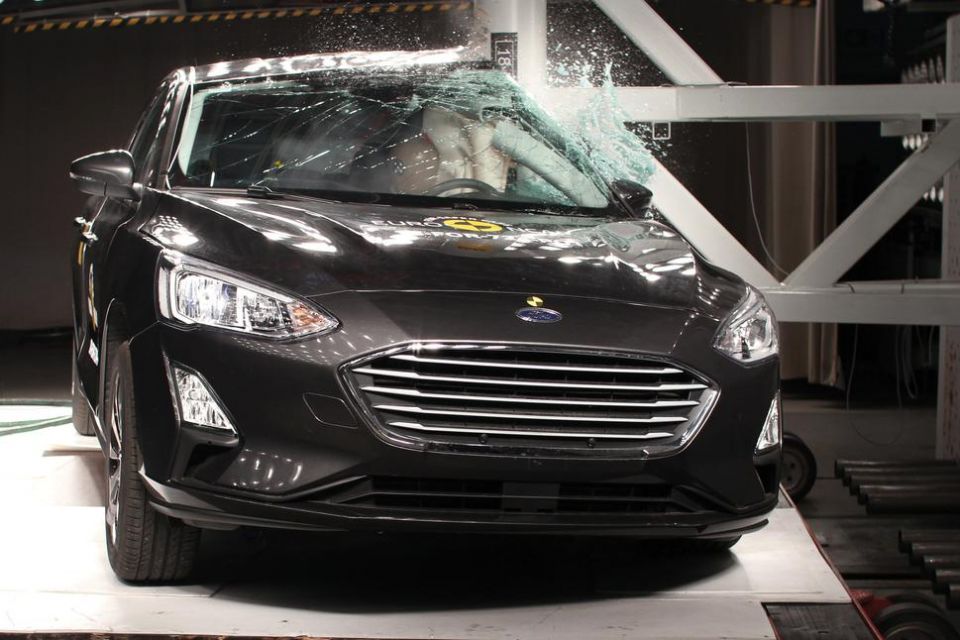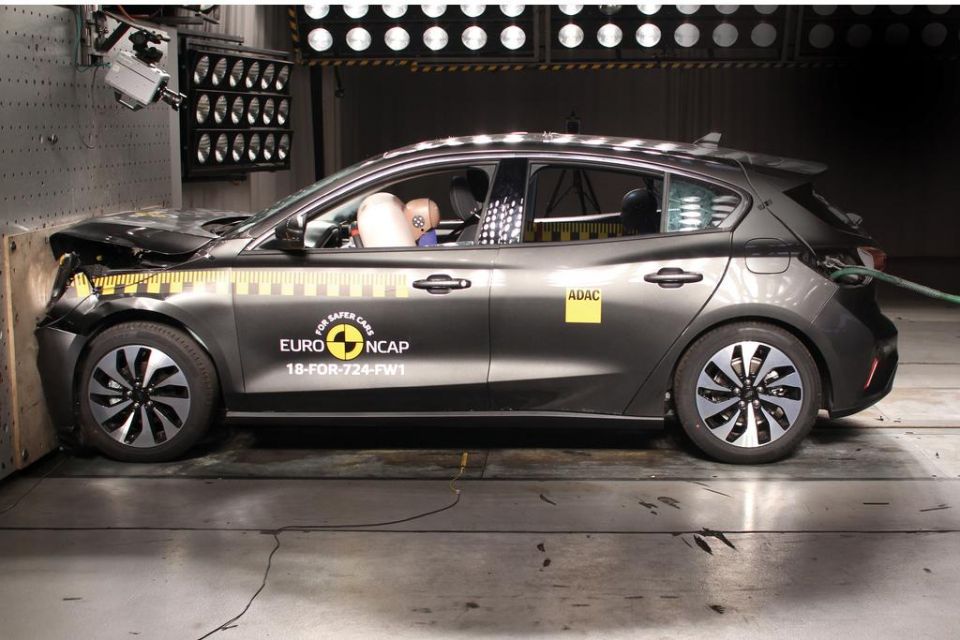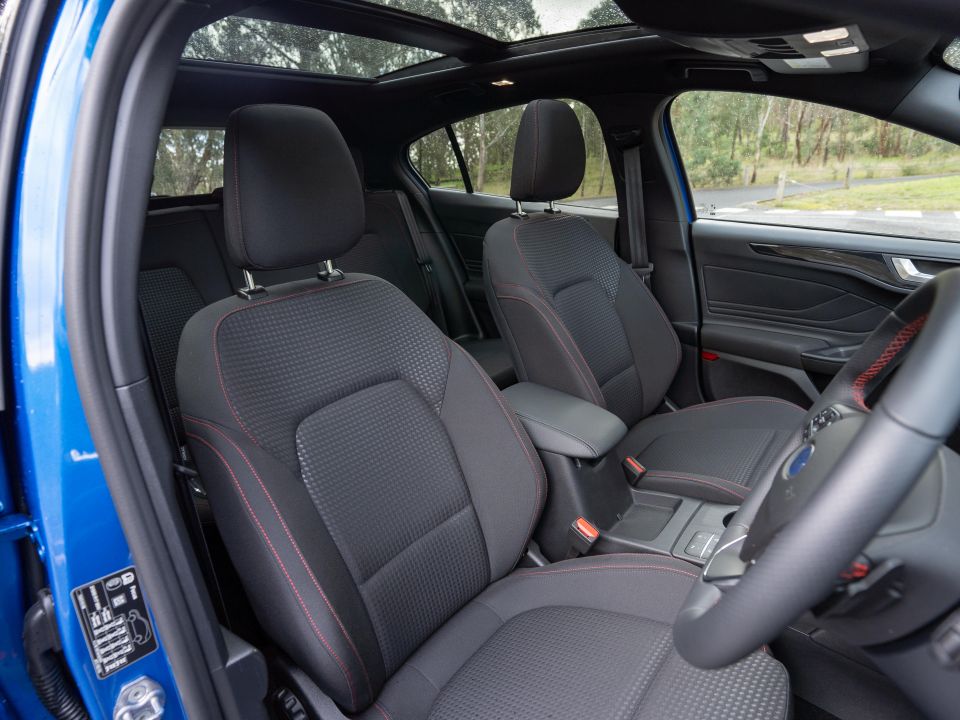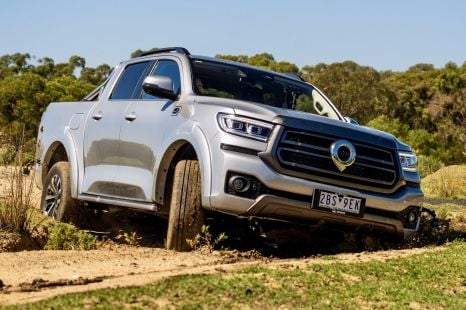

Paul Maric
This Tesla self-drove me 50km to Bunnings on its own (almost)
6 Days Ago
The Focus ST-Line is one of the best-kept secrets in the small car class, offering warm hatch performance and dynamics with a dash of class.



Marketplace Editor
New from
$26,490
excl. on-roads

Marketplace Editor
New from
$26,490
excl. on-roads


Marketplace Editor
New from
$26,490
excl. on-roads

Marketplace Editor
New from
$26,490
excl. on-roads
Quickly see how this car stacks up against its competition. Select any benchmark to see more details.
Where expert car reviews meet expert car buying – CarExpert gives you trusted advice, personalised service and real savings on your next new car.
The Ford Focus has to be one of the most underrated and under-appreciated vehicles on the market today.
Once a staple of the small car segment Down Under, the Euro-centric Focus hasn’t had much traction in the Australian market of late. More broadly, Ford of Europe products continue to be ignored by Australians.

Backed by German design and engineering (and currently, production), the Ford focuses on sharp, engaging driving dynamics and intuitive technologies compared to more mundane, comfort- or practicality-focused rivals.
The current SA-generation Focus first launched in Australia at the tail end of 2018, but for 2021 a range cut spelled the end of the base Trend, top-spec Titanium, and ST-Line wagon.
It also meant the ST-Line finally picked up the more dynamic multilink rear suspension previously reserved for the crossover-styled Active and now-defunct ST-Line wagon.
The 2021 Ford Focus ST-Line you see here is the new entry point into the range. Is it worth your consideration?

Our 2021 Ford Focus ST-Line test vehicle starts at $30,990 before on-road costs and options.
Extras fitted to the vehicle on test include the Driver Assistance Package ($1250) and the Panorama Roof Pack ($2000) and Desert Island Blue prestige paint ($650) bringing the as-tested sticker to $34,890 plus on-roads.
The full price list for the 2021 Ford Focus range is below:
All prices exclude on-road costs

It’s worth noting there are usually drive-away deals to be had, and at the time of writing Ford Australia is advertising the Focus ST-Line for $32,990 drive-away – nearly $2500 off RRP.
Relative to competitors, the Focus has gone from one of the more expensive offerings to middle of the pack.
Key rivals for the Focus ST-Line include the Honda Civic RS hatch ($35,600), the Hyundai i30 Hatch N Line DCT ($31,420), the Kia Cerato GT ($35,990 drive-away), the Mazda 3 G25 Evolve auto ($31,190), the Skoda Scala Monte Carlo ($34,990 drive-away), Toyota Corolla ZR ($32,695), and the new Volkswagen Golf 110TSI Life ($34,250).
Even fully optioned, the Focus is competitive price-wise within the sporty small hatchback segment, despite the fact it hails from Germany.

Standard equipment for the Focus ST-Line includes:


The optional Driver Assistance Package ($1250) adds the following:
Meanwhile, the Panorama Roof Pack ($2000) adds:
Unfortunately, you can no longer option the Design Pack of previous ST-Line and Active models, which brought adaptive LED (projector type) headlights with adaptive high-beam and dynamic front indicators, as well as 18-inch machined alloy wheels.
You also can no longer get a head-up display in local Focus models unless you shell out (and wait) for the ST-3 flagship coming later this year, and the 10-speaker B&O Play premium audio system previously standard on the Titanium is now reserved for ST variant.

It’s a shame Ford Australia hasn’t aligned the ST-Line and Active in Australia closer with the ST-Line X and Active X specifications in Europe, where they get full-LED headlights, LED tail lights, a 12.3-inch digital instrument cluster, 18-inch machined alloys, leatherette/cloth combination trim, power driver seat adjustment, headed front seats, and padded leatherette knee rests.
The overseas trim level also offers the option of adaptive LED headlights, the 10-speaker B&O audio system, and a head-up display.
These items would make the Focus far more competitive. They’d potentially make it a leader against its rivals, even if Ford upped the base price to between $32,990 and $34,990 or made it a standalone model.
As rivals are constantly updated and equipment lists enhanced, it could really serve as an opportunity for Ford to pitch the Focus as a strong value European alternative, like a Skoda.

The Ford Focus wears a five-star ANCAP safety rating, based on tests conducted by Euro NCAP in 2019.
Category scores included 96 per cent for adult occupant protection, 87 per cent for child occupant protection, 72 per cent for pedestrian protection and 72 per cent for safety assist.
All 2021 Ford Focus models come standard with the following safety equipment:

The optional Driver Assist Package ($1250) on ST-Line and Active models adds adaptive cruise control with stop/go and lane centring, blind-spot monitoring and rear cross-traffic assist.
Focus ST variants receive adaptive cruise control as standard, though the six-speed manual lacks stop/go for the adaptive cruise control. The upcoming ST-3 flagship gets all of the Driver Assist Package as standard.
For most of 2021, new ST variants will oddly miss out on blind-spot monitoring and rear cross-traffic assist despite previously fitting the systems as standard, though it will become available again later in the year.

If you’ve sat in a current-generation Focus, just about nothing has changed since its introduction.
There’s certainly a Germanic feel to the ambience, with an insulated feel from the outside world, solid build quality with a mix of soft-touch and hard-wearing surfaces, as well as well-damped switchgear.
Some might find the colour scheme a bit drab, even with the pops of red stitching in the ST-Line and the fake carbon inserts, while the overall approach to ergonomics and switchgear is pleasingly conventional and familiar in an age where manufacturers are moving to touch panels and capacitive controls.




With that said, the centre console shifts a bit if you apply enough pressure, though we don’t think owners will be doing this on a regular basis. Everything else feels well screwed together.
Space and comfort up front is pretty good, with plenty of manual adjustment in the driver’s seat and steering wheel. Despite being the ‘sporty’ model, the ST-Line’s seats aren’t as heavily bolstered as you might expect, so while more forgiving for a range of body types the front buckets don’t ‘hug’ you tightly.
The chunky leather-wrapped steering wheel is nice to hold, and the multifunction controls easy to use. Ford’s analogue driver’s cluster is clean and legible, but lacks the visual appeal of a virtual cluster.




We’re big fans of the Sync 3 infotainment system, namely its ease of use and quick response times. There’s also DAB+ radio, wired Apple CarPlay and Android Auto, and inbuilt satellite navigation with live traffic updates.
An added benefit and relatively unique offering in the segment is the inclusion of the FordPass Connect embedded modem, which allows for the real-time traffic updates mentioned earlier, as well as remote functions (like vehicle lock/unlock and start) via the FordPass smartphone app.
You can also access vehicle diagnostics and get service alerts via the phone app. It’s an early taste of connected vehicle technology.




Storage is pretty good up front, with a large cubby under the centre stack (including a wireless phone charger), felt-lined door pockets, two cupholders and an espresso holder along the centre console, as well as a decent cubby under the front centre armrest.
The second row is on the more spacious side, and outdoes rivals like the Hyundai i30 and Mazda 3. Adults can sit behind adults comfortably – I’m a touch over 6’1″ and had plenty of room behind my own driving position.
Oddly, there’s no air vents (really?!) or fold-down centre armrest in the back, with amenities limited to net-like map pockets on the backs of both front seats, as well as a 12V outlet and felt-lined bottle holders in the doors.




Where expert car reviews meet expert car buying – CarExpert gives you trusted advice, personalised service and real savings on your next new car.
Material quality takes a hit for the rear door trims, which revert to hard, scratchy plastics compared to the soft-touch fronts. ISOFIX points on the outboard rear seats and top-tether points across the second row make it more kid-friendly.
Further back the Focus offers 341L of cargo capacity with the back seats in place and 1320L with them folded. While more accommodating than a Mazda 3 hatch (295L) it’s a bit off the mark, at least on paper, compared to the i30 (395L/1301L) and Golf (381L/1287L) in five-seat configuration.
The Focus also doesn’t have a movable load floor, meaning when the seats are folded flat there’s a noticeable ‘hump’ between the boot floor and seat backs.
A space-saver spare lives under the luggage area floor.

Power in non-performance versions of the Ford Focus comes from a 1.5-litre ‘EcoBoost’ three-cylinder turbo petrol engine, coupled with an eight-speed automatic transmission as standard.
Outputs are rated at 134kW (6000rpm) and 240Nm (1750-5000rpm), with drive sent exclusively to the front wheels. ST-Line variants also feature steering-mounted paddle shifters.
It’s one of the more powerful vehicles in the class, though it’s out-punched by the Hyundai i30 Hatch N Line/Kia Cerato GT (150kW/265Nm) and the Mazda 3 G25 (137kW/252Nm) – though the Mazda’s lack of a turbo means it doesn’t have the low-down shove of the Ford.

The Focus is also fairly unique in the segment for offering an eight-speed transmission, with only the new Mk8 Golf also offering as many ratios before you get to the premium segments.
Overseas the Focus is available with a range of engines, including turbo-diesel and mild-hybrid turbo petrol options, though these aren’t on the table for our market.
Claimed fuel use is rated at 6.4L/100km, with 95RON premium unleaded required as a minimum for the 52-litre fuel tank. Idle stop/start tech is standard too.

Arguably the biggest part of the Focus ownership experience is the drive, and like previous generations Ford’s small hatch remains among the best in the business.
From the moment you set off, you feel super connected to all aspects of the vehicle – throttle, steering, ride. If you want to feel engaged during your daily drive, this is one of very few ways to do it.
Performance from the 1.5-litre turbo is strong. Don’t let the cylinder count fool you, peak torque is available right across the rev range, and there’s plenty of gears to play with so you’re always in the torque band.
Add to that the gravelly, charming note of the three-pot petrol, and it really is a fun thing to drive to work or up a winding B-road.

Ford doesn’t quote an official 0-100km/h time for the standard Focus, though UK publications have recorded circa 8.0-second dashes with this engine. While it won’t set the world on fire, 0-60km/h or 0-80km/h are where this engine does its best work, and certainly feels quicker than the numbers suggest.
Given this is a version of the same 1.5-litre petrol engine used in the Fiesta ST hot hatch (147kW/290Nm), you can understand the warm hatch-like personality.
We’d avoid using the paddle shifters even in Sport mode, as the transmission is slow to react to inputs regardless of whether you’re shifting up or down. It’s a complaint I remember making when this generation launched, so it’s a shame this hasn’t been rectified now that this current generation has been on sale for three years.
Something I love, though, is how direct, accurate, and responsive the steering is. I don’t know if there’s a mainstream-branded vehicle that offers such sharp steering and feedback.

It might take some getting used to if you’re used to a lighter, more numb feel, but it really helps to make the Focus feel like an extension of you on the move, and means less input with more precision.
This really translates to a fun drive when things get twisty, as you can corner with confidence regardless of speed and the MY21 model’s independent rear suspension feels a little better tied down than the old torsion beam setup.
Further, the more sophisticated rear end means ride compliance in daily driving is much more resolved too. Going over undulations, speed humps and the like, the latest Focus offers better rebound and absorption, especially with the ST-Line’s firmer and lower (-10mm) sports suspension.
My brother recently bought a used MY19 Focus Trend, which runs the old torsion beam setup. Having ridden in both, the old Trend (and old ST-Line from memory) has the tendency to be a bit sharper at the rear and be more abrupt in recovery over bumps.
In isolation you’d barely notice, in all fairness, but it’s definitely an improvement.

Having eight gears and a more comfortable ride means the Focus ST-Line is one of the more capable tourers in the class, too.
While not as hushed or cushy at speed as say, a Mazda 3 or a Golf, the Focus happily hums away under 2000rpm in eighth gear at freeway speeds, with the optional adaptive cruise and lane centring systems taking the load off longer stints behind the wheel even more.
Ford’s assist systems seem to be less intrusive than some rival brands, though many will find the lane centring something to get used to. It’s also easily turned off via a button on the steering wheel, but it does what it says on the tin.
The cabin is pretty well insulated from wind and road noise at all speeds, though coarse-chip roads will be noticed, with a bit of tyre roar entering the cabin.
It’s a shame Ford doesn’t offer a manual for the ST-Line in Australia like it does overseas. That’d really transform this already fun and engaging car into a proper enthusiast’s pick.

Like the wider Ford line-up, the Focus is covered by a five-year, unlimited-kilometre warranty with up to seven years of roadside assistance through auto club membership if you maintain your vehicle with a participating dealer.
It also includes access to the Ford Service Benefits program, which includes roadside assistance through complementary auto club membership, and yearly satellite navigation map updates.
Service intervals are quoted as 12 months or 15,000 kilometres – whichever comes first.

Each of the first five services costs $299, $299, $299, $299 and $350 respectively – totalling $1546 for 60 months or 75,000km.
While not as cheap as a Toyota Corolla to service, the Focus is one of the more affordable models in its class in terms of scheduled maintenance.
As for real-world fuel consumption, we saw an indicated 8.0L/100km over 470km, with our week of testing skewed to peak-hour commuting. Not bad, if a bit up on Ford’s 6.4L/100km claim.
That works out to a theoretical range of around 600 kilometres per tank.

The Ford Focus accounts for just 1.0 per cent of all mainstream small car sales in Australia, and that’s a crying shame.
Given its dynamic talents, cabin practicality, and decent equipment list, it certainly deserves to be doing much better in the Australian market.
Is it perfect though? No. There’s a slew of features we don’t get that Europe and the UK do, despite coming from the same factory, and niggles like the lack of rear air vents and the lazy paddle shifters make small dents in an otherwise capable all-round package.
Still, it’s a talented car – and you might be able to get a decent deal on one given the limited popularity.

Click the images for the full gallery by Wesley Loh (@garagetribe on Instagram)
Where expert car reviews meet expert car buying – CarExpert gives you trusted advice, personalised service and real savings on your next new car.
James is an automotive journalist based in Melbourne, Australia. Before joining CarExpert.com.au in 2020, James has worked at leading auto media outlets including Carsales and CarAdvice, as well as at Pulse agency for Ford Australia's communications team. In 2019 James made Mumbrella's 'Top 20 most prolific web authors in Australia' list after publishing 1,360 articles between March 1, 2018 and February 28, 2019 for CarAdvice. James is also an Ambassador for Drive Against Depression – an Australian charity whose mission is to support mental wellness through the freedom of driving and a shared love of cars.


Paul Maric
6 Days Ago


Anthony Crawford
5 Days Ago


Max Davies
4 Days Ago


James Wong
3 Days Ago


James Wong
2 Days Ago


Max Davies
1 Day Ago